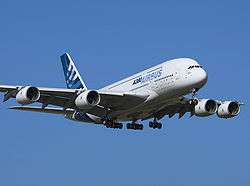Droop (aeronautics)

A droop or droop nose is a type of high-lift device found on the wings of some aircraft. Droops are similar to leading-edge slats, but with the difference that the entire leading edge section rotates downwards, whereas a slat is a panel that moves away from a wing leading edge when it is deployed.[1]
Location
Droops are a type of leading edge device, mounted as they are on the rounded front part of a wing. The Airbus A380 has a droop between the fuselage and each inboard engine, at the leading edge of the thickest part of each wing.[1][2] Early variants of the Hawker Siddeley Trident had two droops on the outboard of each wing and a Krueger flap on the section closest to the fuselage.[3]
Use and effect
Droops function with other high-lift devices on an aircraft to increase the camber of the wing and reduce the stalling speed. On the Airbus A380, the first stage of lift device selection deploys the droops (called droop noses by Airbus) and leading-edge slats located further out on the wing; with the flaps starting to extend when the second stage is selected. The droops on the A380 may be deployed to a position 22 or 25 degrees lower than their stowed position.[2] Another function of the droops on the A380 is to change the stall characteristics of the wing.[4] The A380's designers found that the airflow between the engines was separating from the wing surface prior to the airflow between the engine and the fuselage, an undesirable characteristic. Adding a droop between the engine and the fuselage fixed the problem; whereas using a leading-edge slat would not have done so because of the gap (or slot) created between a slat and the wing when a slat is deployed.[4]
Aircraft fitted with droops
- Airbus A380
- Airbus A350
- Dassault Falcon 20
- Hawker Siddeley Trident
- Mikoyan-Gurevich MiG-23
- Northrop F-5
See also
- British European Airways Flight 548 - a Hawker Siddeley Trident crash in which premature retraction of the droops was a factor
- Variable camber wing
References
Notes
Bibliography
- "Inquiry briefing". Flight International. London: IPC Business Press. 101 (3303): 932a–934. 29 June 1972.
- Norris, Guy; Wagner, Mark (2005). Airbus A380: Superjumbo of the 21st Century. St. Paul, Minnesota: Zenith Press. ISBN 0-7603-2218-X.